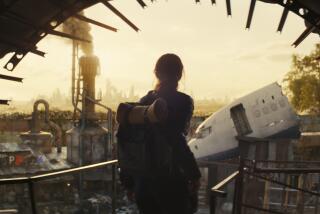A wary drive up to the gate of Fukushima
- Share via
Reporting from Futaba, Japan — The radiation gauge beeped, signaling that isotopes were in the atmosphere.
As our SUV followed a line of electricity towers marching across deserted farmland, we made an agreement: If the dosimeter hit 15, we’d turn around. The device inched up to 12, its faint beep seeming more like a scream. Each time, edgily, we called out the number.
Thirteen.
The ventilation was off and the windows were sealed tight, even though the afternoon was warm. With our heads covered and our mouths sheathed in breathing masks, the SUV became a sauna as we bumped along roads with cracks as wide as a man’s head.
The minutes ticked by.
Fourteen.
Miles past a police checkpoint, we finally saw it. In Japanese and English, a large blue sign. Fukushima, the place where no one else in the world wanted to be.
We — two journalists, an interpreter and a driver — wanted to see the villain at the center of Japan’s nuclear nightmare. As we pulled up to the gate, we knew that somewhere in the near distance, scores of workers were scrambling to bring the damaged reactors under control.
But those efforts were as invisible as the nuclear threat itself.
Suddenly, as we approached the main gate, security guards were upon us, two figures who’d seemingly stepped out of “Star Wars,” menacing in their dual-intake respirator masks and head-to-toe white hazmat gear.
Peering into the SUV, expressions obscured, they shook their heads as they waved us off, refusing to answer questions, repeating the dismissive circular hand motion for a U-turn.
They noted our license plate as we turned around and slowly embarked along a side road, briefly trailed by guards in another vehicle.
A hundred yards away, several mysterious towers shone white in the afternoon sunlight, hiding their secrets. It was difficult to get a bead on the place; trees seemed to have been placed strategically to prevent a full-on view of things.
To the side, we saw a sign posted by the nuclear plant’s safety committee. It carried an announcement: “This month’s safety slogan: Make sure to check everything and do the risk assessment. The goal is zero disasters for this year.”
In the weeks since the March 11 tsunami destroyed Fukushima’s emergency cooling system, people as far away as California have fretted over full nuclear meltdown at the plant 155 miles north of Tokyo. Explosions in four of Fukushima’s six reactors have spewed dangerous radioactive isotopes of iodine, cesium and strontium, which can cause bone cancer and leukemia.
Most residents within 18 miles have evacuated, leaving behind a post-apocalyptic landscape and a decades-old plant that’s now sick and dying.
We traveled to Fukushima with questions. What does it look like? Smell like? Would they let us inside? So far, the few pictures have come from aerial fly-bys that showed smoking reactors in a soulless industrial setting.
As we neared the coastal plant, we peered out the SUV windows, trying to create a lasting mental image of a place many say will one day be sealed off in concrete to protect against nuclear poisoning.
The best description of the scene: silence. We mostly stayed inside the vehicle, but once in a while, we opened a window, or briefly jumped out to take a picture. And we listened.
They say that following the 1986 Chernobyl disaster, the birds stopped singing. At Fukushima, we didn’t hear birds, or anything else. No children shouting, no car horns honking, not even the waves on the too-distant shore. Just the wind.
Fukushima translates as “fortunate isle,” and it once signified purity, used to brand fruit and vegetables. Now it carries the whiff of Armageddon.
This week, officials raised the severity rating of the nuclear crisis to a maximum level 7, a threshold reached only once before in the history of nuclear power, at the now-shuttered Chernobyl reactor.
We didn’t make the decision to go to Fukushima lightly. We brought along the dosimeter, which gives an accumulated total of radioactivity exposure. The device was loaned to us by a scientist who assured us it was safe to travel near the reactor as long as there was no explosion. Otherwise, our exposure would be equivalent to what we might get on a cross-country flight. In other words, not that much — a level people experience daily. (An exam later at a nearby center confirmed it: We tested negative for radiation.)
Still, our interpreter was worried at first. A 22-year-old college student, she wants to have children one day. The driver, on the other hand, never blinked. Also 22, he had on a previous trip to the hot zone worn a shirt that read, “It is a good day to die.”
In the end, we didn’t merely leave the plant; we fled. On the rise of a hill, we looked back a last time at the complex, but we saw nothing except the trees that shelter it from prying eyes.
More to Read
Sign up for Essential California
The most important California stories and recommendations in your inbox every morning.
You may occasionally receive promotional content from the Los Angeles Times.











